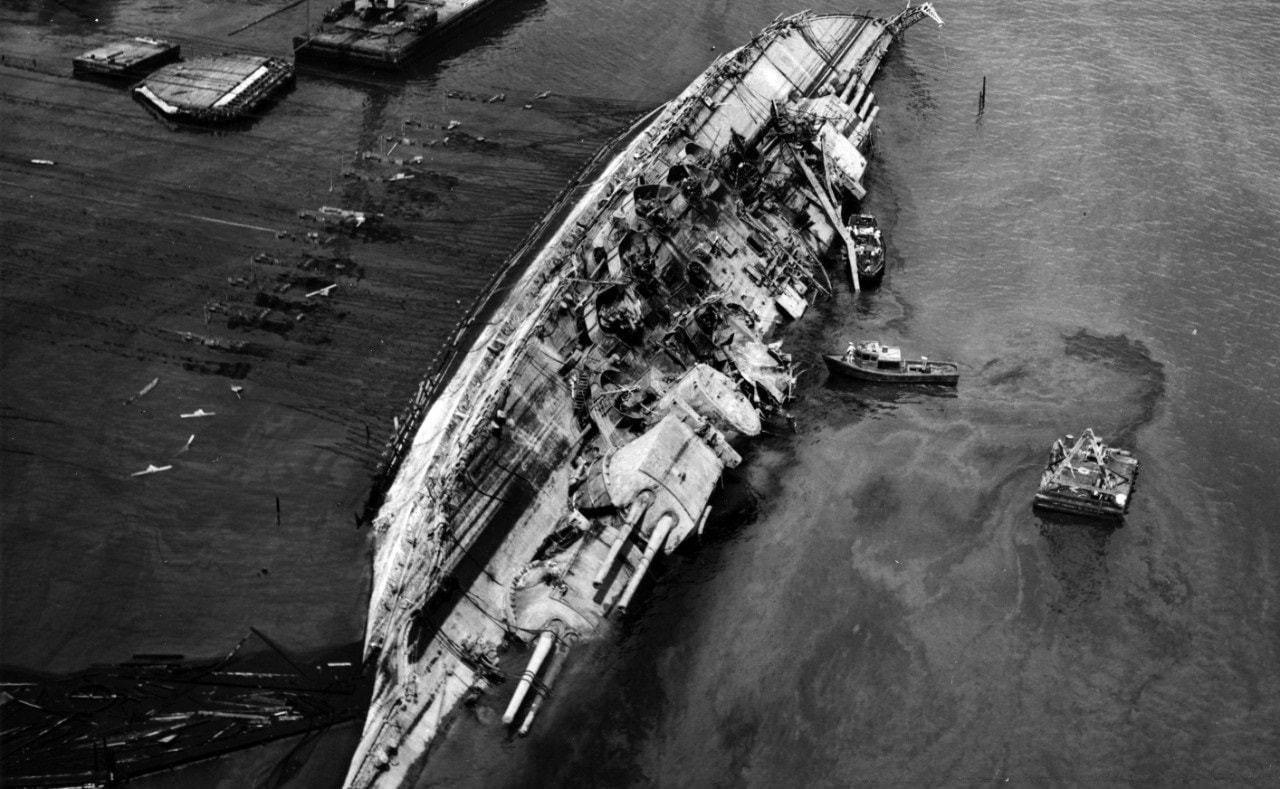USS Oklahoma, a Short History: Today there is a memorial at Pearl Harbor to honor the 1,177 U.S. sailors and Marines killed in action aboard the USS Arizona (BB-39), which was hit by four Japanese aerial bombs on December 7, 1941. A lesser-known memorial was dedicated in 2007 to pay tribute to the other U.S. Navy battleship that was sunk and unable to return to duty after the Japanese sneak attack on Hawaii.
The USS Oklahoma Memorial is now a fixture on Ford Island, the result of a campaign mounted by some in the Sooner State. Cmdr. Tucker McHugh, U.S. Navy (Retired) was among those who lead the efforts to build a permanent memorial to USS Oklahoma (BB-37), which was hit by eight torpedoes at the very start of the attack on that sunny Sunday morning 80 years ago. In less than 12 minutes, she rolled over until masts actually touched the bottom, trapping hundreds of men inside and under the war.
Of those trapped inside only 32 crew members were rescued, while 415 sailors and 14 Marines died during or after the attack.
The Career of the USS Oklahoma
The Nevada-class battleship was built by New York Shipbuilding Corporation and was commissioned in 1916. As part of the first U.S. Navy class of oil-burning dreadnoughts, the warship had a greater range than previous battleships.
BB-37 served in the latter stages of the First World War as part of Battleship Division Six, which protected Allied convoys traveling across the Atlantic. After the end of the war, USS Oklahoma served in both the United States Battle Fleet and Scouting Fleet. Modernized between 1927 and 1929, she had a greatly altered appearance but notably improved battleworthiness. The battle wagon was deployed to Spain during that nation’s Civil War in July 1936 to rescue American citizens and refugees.
She rejoined the Battle Fleet in the Pacific later that year.
In 1940, USS Oklahoma‘s base was shifted from the U.S. West Coast to Pearl Harbor, Hawaii, and she was among the eight battleships at Pearl Harbor when the Japanese attacked on 7 December 1941. She had returned late from a training mission on the night of December 5, and there was only a single position on battleship row. Moored outboard of USS Maryland (BB-46), Oklahoma was exposed to the bay – making her among the most exposed warships when the attack began.
The battleship was hit by a number of Japanese Type 91 aerial torpedoes that tore open her port side. She capsized at 8:08 am HST, just 12 minutes after the first torpedo hit.
Along with USS Arizona, USS Oklahoma was among two of those eight battleships not to return to service. However, in 1943, the battleship was the subject of a massive salvage undertaking, involving turning her upright, patching her damages and refloating her. She was drydocked late in the year to be stripped of guns and other equipment and repaired sufficiently to make her relatively watertight. Too old and badly damaged to be worth returning to service, instead USS Oklahoma was formally decommissioned in September 1944. She was sold for scrapping in December 1946, but sank while under tow from Hawaii to California in May 1947
Remembering Oklahoma
While other battleships had been memorialized after the war, such was not the case with BB-36.
“We thought, ‘That’s not right that the USS Oklahoma does not have any kind of memorial,'” Cmdr. McHugh told The Journal Record newspaper. “The fact that 429 men on the USS Oklahoma died that day … and there was nothing to honor them individually with their names on anything. That was just not right. That was not going to stand, so that’s why we built the memorial.”
Tucker, along with retired Rear Adm. Gregory Slavonic, Oklahoma City architect Don Beck and a handful of other Oklahomans, were able to raise $1.5 million in private donations, which resulted in a lasting tribute to the USS Oklahoma’s fallen heroes. The black granite and white marble memorial was dedicated on December 7, 2007. The names of those who lost their lives on the ship are engraved in black granite on 429 individual white marble columns, each of which is 7 feet tall and weighs 120 pounds.
“There are rows of these standards representing each individual that lost their life,” added architect Beck. “You can walk between these rows, and the idea is you can walk among the lost souls and get a feeling of what it’s like to see 429 who gave their lives.”
MORE: Is Russia’s Su-57 Felon Stealth Fighter a Total Bust?
MORE: Merkova: Israel Has A Super Tank
Peter Suciu is a Michigan-based writer who has contributed to more than four dozen magazines, newspapers and websites. He regularly writes about military small arms, and is the author of several books on military headgear including A Gallery of Military Headdress, which is available on Amazon.com. He is a contributing writer for Forbes Magazine as well.

